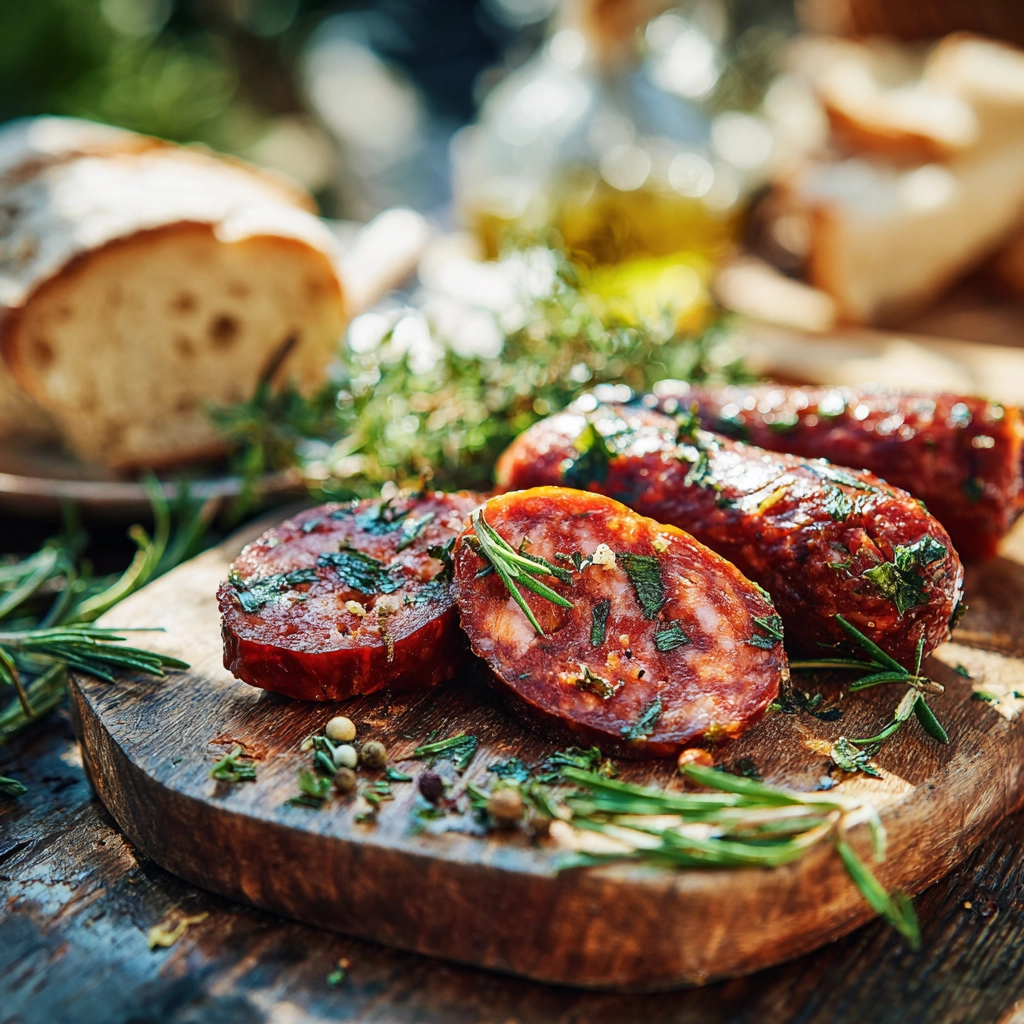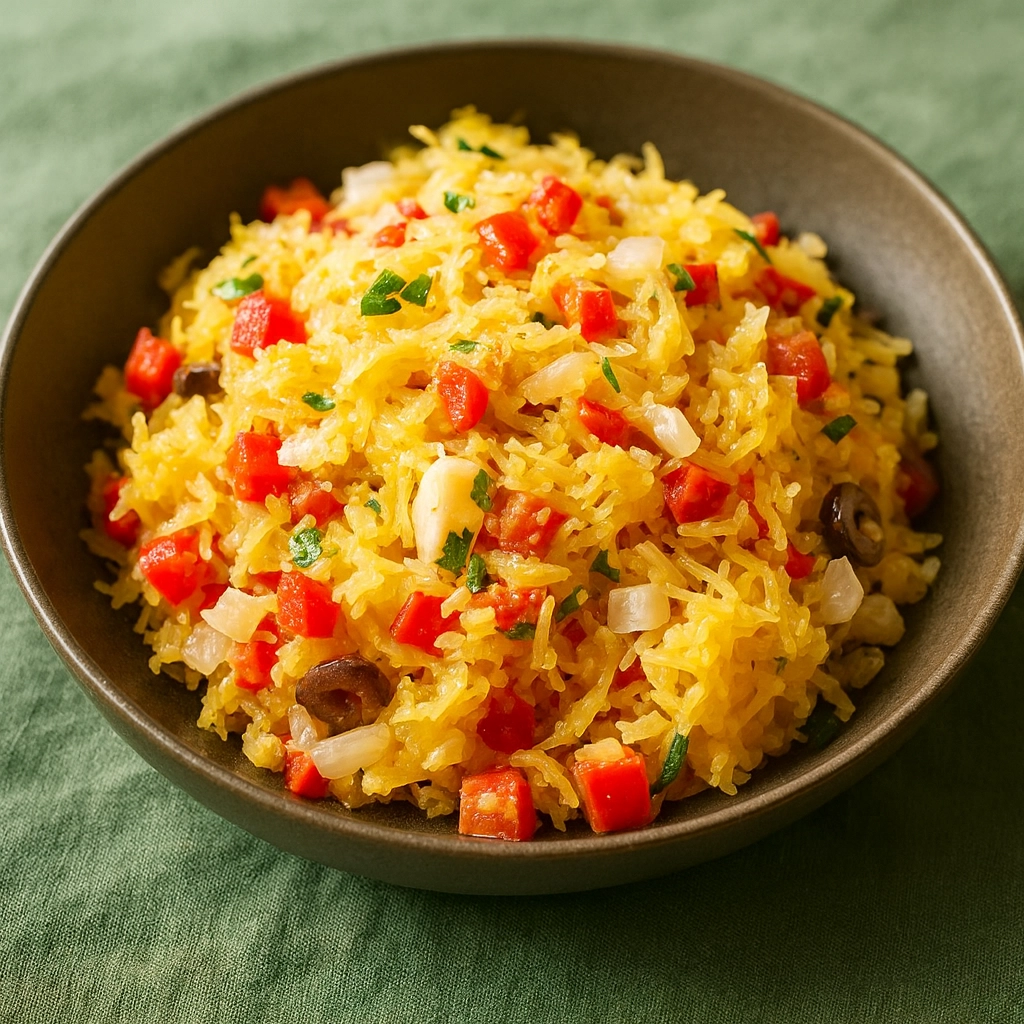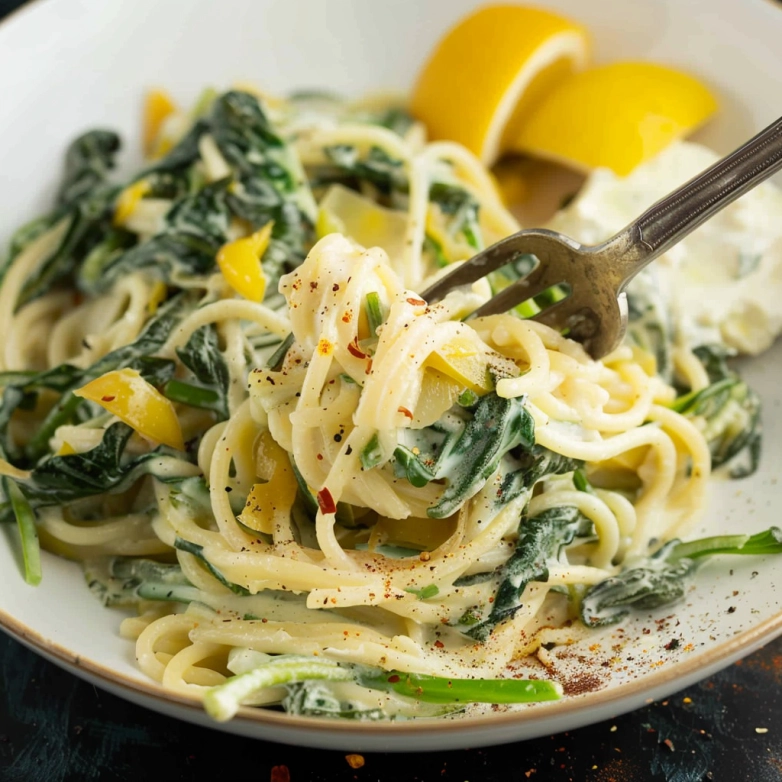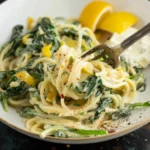From the smoky hills of Calabria to the rustic charm of Sicily, sausages in Italian cuisine are rich in flavor and cultural history. Whether it’s spicy ‘nduja or herby Sicilian salsiccia, each region brings something special to the table. These flavorful links aren’t just ingredients—they’re centerpieces of beloved meals. In this guide, we’ll explore iconic types, regional secrets, and the best ways to use Italian sausages at home. If you enjoy comforting dishes like our Garlic Parmesan Chicken Pasta, you’ll love learning how sausage can transform your meals too.
Table of Contents
The Story Behind My Love for Italian Sausage Dishes
My love for sausages in Italian cuisine began in my aunt’s kitchen in Palermo. The sizzle of fennel-laced sausage in a hot pan, paired with the warmth of tomato sauce, sparked my earliest food memories. Today at FlavourRecipe, I share that same passion through dishes inspired by Italy’s most beloved traditions. Recipes like our Marry Me Chicken Pasta carry the same comfort—and with sausages in Italian cuisine, that comfort deepens. From spicy Calabrian links to savory Tuscan varieties, these sausages tell a story through every bite. Let’s uncover what makes them so essential to Italian cooking.
Regional Varieties of Sausages in Italian Cuisine
Sicilian Sausages: Fennel, Beef, and Bold Island Flavors
Sicilian sausage is a bold staple in sausages in Italian cuisine. Made primarily with ground beef, garlic, and wild fennel seeds, this variety bursts with aromatic intensity. Some versions include local red wine or spicy Calabrian chili for extra heat. Unlike Northern sausages, Sicilian links aren’t shy about flavor—they’re rustic, punchy, and unapologetically rich.
One standout is the salsiccia al finocchietto, which showcases the native wild fennel of Sicily. These sausages are often grilled at street markets or simmered in sauce for comforting pasta meals. For a satisfying twist, try using beef sausage in place of chicken in recipes like our creamy Garlic Parmesan Chicken Pasta.
Calabrian, Tuscan, and Northern Sausages: A Tour of Italy in Every Bite
In Calabria, you’ll find the fiery ‘nduja—a spreadable, spicy sausage made with seasoned beef, roasted red peppers, and chili paste. It melts perfectly into sauces or even on toasted bread. This variety adds a signature southern kick to sausages in Italian cuisine, showcasing bold regional personality.
By contrast, Tuscany offers more herbaceous sausages flavored with beef, white grape juice, rosemary, and black pepper. These pair beautifully with lentils or tossed into a bowl of rigatoni. In the north—places like Lombardy and Veneto—sausages are milder and often paired with polenta or slow-cooked in stews.
These regional flavors represent more than just ingredients—they capture climate, culture, and history. Whether it’s the heat of Calabria or the earthy richness of Tuscany, sausages in Italian cuisine carry a taste of Italy in every bite.
What’s Inside Sausages in Italian Cuisine: Ingredients & Methods
Key Ingredients: Beef, Herbs, and Regional Secrets
PrintSausages in Italian Cuisine: A Remarkable Guide to Bold, Traditional Flavors
A flavorful overview of traditional Italian sausages made with beef, including tips on how to cook, serve, and enjoy them at home.
- Prep Time: 10 minutes
- Cook Time: 15 minutes
- Total Time: 25 minutes
- Yield: 2 servings 1x
- Category: Dinner
- Method: Sautéing
- Cuisine: Italian
Ingredients
500g ground beef sausage
1 tsp wild fennel seeds
2 cloves garlic, minced
1/2 tsp chili flakes
1 tbsp olive oil
Fresh parsley, chopped
Instructions
1. Heat olive oil in a skillet and sauté garlic until fragrant.
2. Add sliced beef sausage and cook until browned.
3. Sprinkle in fennel and chili; stir for 1–2 minutes.
4. Add to your favorite pasta or serve with bread.
5. Garnish with fresh parsley before serving.
Notes
Substitute chili flakes with smoked paprika for a milder flavor.
Pairs well with creamy sauces or tomato-based pasta.
Nutrition
- Serving Size: 1 bowl
- Calories: 520
- Sugar: 3g
- Sodium: 700mg
- Fat: 34g
- Saturated Fat: 12g
- Unsaturated Fat: 18g
- Trans Fat: 0g
- Carbohydrates: 20g
- Fiber: 2g
- Protein: 32g
- Cholesterol: 90mg
At the heart of many sausages in Italian cuisine is quality ground beef—often mixed with a bit of fat for juiciness and balance. What makes these sausages distinct is their seasoning. In Northern Italy, ingredients like garlic, white grape juice, and sage dominate. In the South, bold additions such as chili flakes, paprika, and wild fennel are more common.
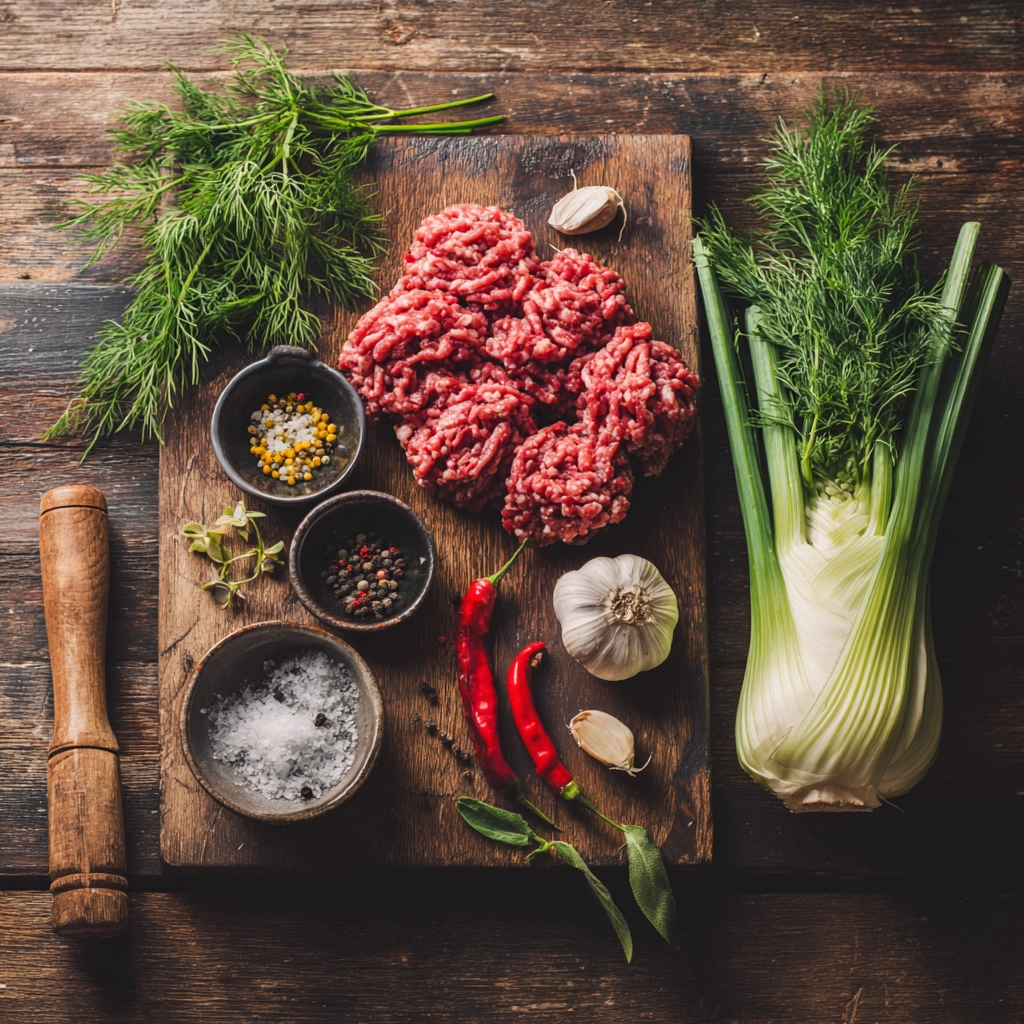
Sicilian-style beef sausages often include chopped parsley, sweet peppers, and sometimes pine nuts, delivering layers of Mediterranean flavor. Calabrian-style sausages are known for their spiciness, using crushed red pepper and smoked paprika. If you love rich, spreadable sausage, you’ll appreciate beef versions of ‘nduja, which melt beautifully into sauces.
These ingredients are more than flavor enhancers—they’re reflections of local heritage. Whether it’s a rosemary-scented beef sausage from Tuscany or a spicy Calabrian blend, each link carries a regional story.
How They’re Made: Fresh, Cured, and Everything in Between
Italian sausages come in two main styles: fresh or cured. Fresh sausages made from seasoned beef are stuffed into natural casings and formed into links. They’re delicious grilled, pan-fried, or slow-simmered in sauce. Try using them in dishes like our Garlic Parmesan Chicken Pasta for a hearty flavor upgrade.
Cured sausages, such as beef versions of soppressata or finocchiona, are air-dried for weeks and sliced thin for antipasti or sandwiches. Their savory, concentrated flavor makes them ideal for casual snacks or elegant platters.
What makes sausages in Italian cuisine so enduring is this versatility. From the spice-forward blends of the south to the herb-rich sausages of the north, beef-based Italian sausages deliver bold flavor and rich tradition—no compromise needed.
Cooking with Sausages in Italian Cuisine at Home
Everyday Recipes with Italian Beef Sausage
One of the best things about sausages in Italian cuisine is how adaptable they are in everyday meals. Whether you’re preparing a weeknight pasta or a cozy Sunday lunch, beef sausages bring bold flavor with minimal effort.
In pasta dishes, sauté slices of Italian beef sausage with garlic, tomatoes, and herbs for a simple yet satisfying sauce. Try using it in place of chicken in our Marry Me Chicken Pasta—you’ll get a deeper, savory flavor that clings beautifully to the noodles.
For something lighter, toss grilled beef sausage with sautéed greens, white beans, and lemon. In colder months, bake them with potatoes and rosemary for a rustic tray-bake that warms the whole house. You can also crumble sausage into meatballs or stuffing for added texture and spice. These simple substitutions elevate your meals while staying rooted in traditional Italian flavors.
Entertaining with Italian Sausage: Platters, Bakes, and Comfort Food
Planning a gathering? Use sausages in Italian cuisine to create stunning antipasto platters. Slice cooked beef sausage thin and serve with marinated vegetables, cheeses, and warm focaccia. For something heartier, layer sausage into lasagna or bake with rigatoni and mozzarella for a bubbling, cheesy main dish.
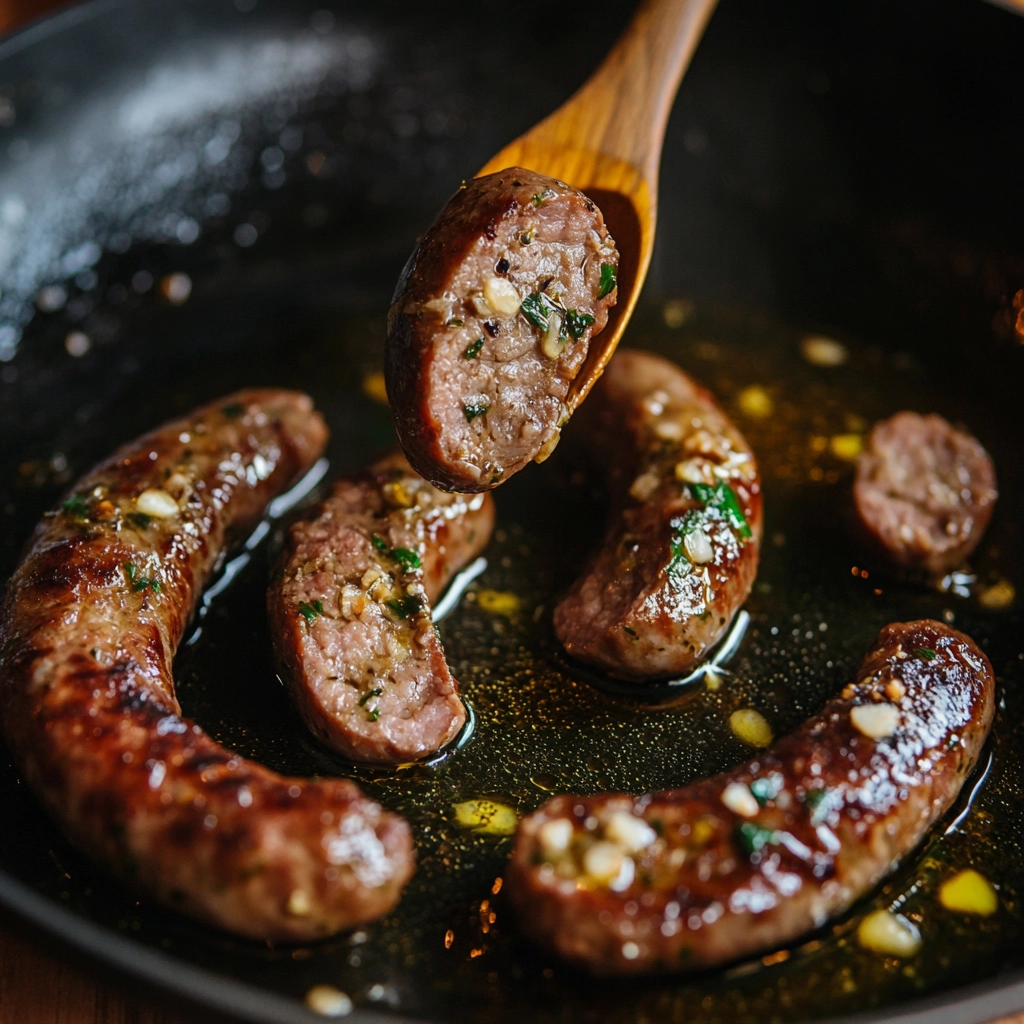
You can also make mini beef sausage rolls wrapped in pastry for quick bites that everyone loves. If you’re aiming for comfort, simmer sausage in a tomato-based stew with lentils or chickpeas—perfect for dipping crusty bread.
No matter the meal or occasion, Italian beef sausage brings both tradition and bold taste to your table. It’s a flexible, flavor-packed ingredient that makes ordinary dishes extraordinary. And like many of our most-loved recipes, it turns simple cooking into something truly memorable.
Conclusion:
Why Sausages in Italian Cuisine Deserve a Place in Your Kitchen
From the smoky flavors of Calabria to the herb-laced richness of Tuscany, sausages in Italian cuisine offer a spectrum of flavor that few other ingredients can match. Whether you’re tossing slices into pasta, grilling them for a rustic meal, or adding them to your antipasto platter, Italian beef sausages bring depth, tradition, and bold taste to every dish.
They’re more than just meat—they’re a connection to culture, history, and shared meals around the table. So next time you’re craving comfort or something new, let Italian sausage inspire your cooking.
For more recipes follow me in Facebook and pinterest.
Frequently Asked Questions about Sausages in Italian Cuisine
What is Calabrian sausage?
’Nduja is a spicy, spreadable sausage from Calabria, made with beef, chili, and salt.
What is a large sausage made from mixed meats named after a town in Italy?
That sausage is Mortadella, from Bologna. It’s a large beef sausage often with fat cubes or pistachios.
What is in a Sicilian sausage?
Sicilian sausage contains beef, fennel seeds, garlic, black pepper, and sometimes cheese.
What are Italian sausages called?
Italian sausages are called “salsiccia” in Italian. In English, they are usually beef sausages with fennel or anise.

